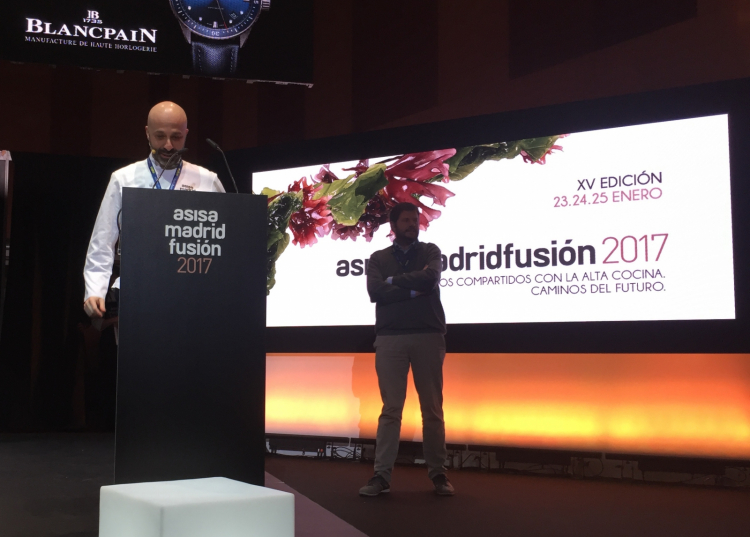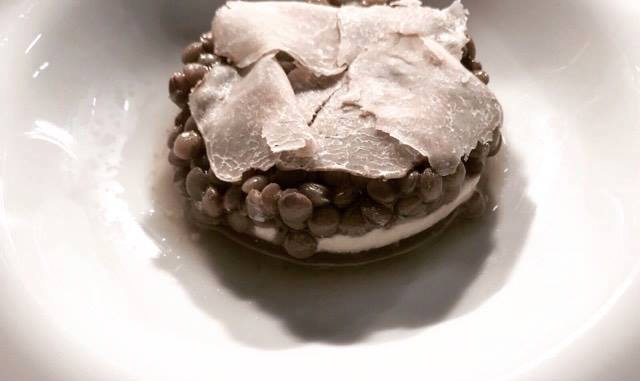Four years exactly have gone by since Niko Romito last appeared at Madrid Fusión, the oldest congress in the industry, this year reaching its 15th edition. In 2012, the chef from Abruzzo focused his lesson on extraction. This time he chooses simplicity, sencillez in Spanish. These two terms are not contradictory, in fact, one is the evolution of the other because, as journalist Marco Bolasco finely explained when introducing him on stage: «Romito’s simplicity is the result of a complex process, of the desire of removing the surface in a ceaseless search for the best. Of extracting, sculpting and then offering a dish in a very serious play that has pleasure as its ultimate goal».
«I’d like to thank José Carlos Capel and Julia Pérez», started Romito, assisted in Madrid by the faithful Dino Como, «for inviting me here once again and most of all for visiting my restaurant and try me cooking. This is not a banal thing, given I work in Castel di Sangro». Not in Milan or Rome. Still, his region, now lashed by snow and earthquakes, is heavenly: «It’s in Central Italy», he adds to uninformed Spanish people, «because in just a few kilometres you move from the seaside to the hills, to the mountains; there’s an incredible variety of ingredients of all kind. On top of 3 parks and 32 reserves, which form one of the greenest areas in Europe».

SHADOW MAN. Behind Niko Romito, Marco Bolasco, director of the gastronomy section at publisher Giunti and Slow Food
The cooking: «In my journey, I took on a double path: emancipation from the logic of regional tradition while keeping a close-knit connection with Abruzzo». The audience finds
Capellini glassati ai porri [Capellini glazed with leek], the first course which he presented in the morning offers him the chance to express other precepts from his philosophy: «I always try to synthesise neatness, as well as respect for the guest, with expedients that are sometimes necessary, such as eliminating fat, which often makes the life of the cook harder. Simplicity is effective only if it results in balance and lightness».
He struggles to apply this principle to every kind of food, from pasta filled with meat, to vegetables. In fact, right after this, a sequence of slides shows dishes we now consider “classics”: among the others,
Smoked lamb with cream of garlic and grapefruit,
Sea bass, capers and parsley,
Tortelli filled with chicken,
Artichoke and rosemary and the now famous
Cabbage and potatoes, «a dish exploring the principles of stratification, one ingredient on top of the other, expressing tertiary flavours». An almost unsettling dish: «When I serve it, guests think it’s roasted veal, or even a fois gras escalope. Then when they taste it they recognise the cabbage and feel reassured».
Helped by smooth teaching skills, for his finale
Romito bets on the
structures & temperatures pair: «These two aspects are rarely spoken of by they’re essential in building a dish because a different level of these two can totally change how a dish is perceived». This is the premise for the only new dish presented during the lesson, at the very last minute. He discusses pulses («In our area, we produce very many varieties»), especially lentils: «We tried to imagine something that would go beyond the usual structure of a soup. We tried to elevate them to the rank of protagonists in the recipe». We steam the lentils, «so we respect their integrity and we cook them in a uniform way». The powder of toasted lentils is brought to the boil, then it rests for many hours in the fridge until we obtain a lentil gelatine.

LEGUME IN THE FUTURE. Lentils, hazelnuts, garlic and white truffle, a new dish from Niko Romito at Madrid Fusión
The second layer of the dish is a Bavarian mousse with hazelnuts and chickpeas, in the same proportion. «Yet you cannot taste the chickpeas, I just use them to give structure to the mousse. I cover chickpeas and hazelnuts with the chickpea water, then freeze it and blend it». The result is a hazelnut paste placed in the middle of the dish: «It almost looks like the structure of a cake». In the end, the dish is a stratification of 3 tastings and 3 different temperatures: there’s the Lentil gelatine at 8°C, the hazelnut mousse at 12°C and the hot lentils on top, aromatised with garlic oil. And above that, there are glazed lentils and white truffle. «So at every spoonful the flavours change. It’s a constant discovery».